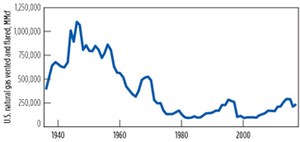What's new in production
What a problem it is: According to U.S. Energy Information Agency data, 235,570 MMcf of gas were flared or vented in the United States during 2017 (see chart on this page). Of course, the problem also resides in many other places, as well. World Bank’s 2016 data show Russia as the world’s largest gas-flaring country, to the tune of about 742 Bcf (21 Bcm) annually; followed by Iraq (565 Bcf or 16 Bcm); Iran (424 Bcf or 12 Bcm); the U.S. (424 Bcf or 12 Bcm); and Venezuela (318 Bcf or 9 Bcm).
According to World Bank, there are more than 16,000 gas flares at oil production sites worldwide, causing about 350 million tons of CO2 to be emitted to the atmosphere every year. Furthermore, flaring in northern areas of the globe is a major source for the black carbon (soot) that deposits on the Arctic ice cap, which accelerates melting.
The organization also points out that flaring “…wastes a natural resource that could be put to productive use or conserved (by re-injecting it into the ground). For example, if the 147 Bcm (5.2 Tcf) of gas flared globally were used for power generation, it could provide about 750 billion kWh of electricity, or more than the African continent’s current annual electricity consumption.”
The end of routine gas flaring. It also notes that a global initiative to end routine gas flaring at oil production sites around the world has now been endorsed by 62 oil companies, governments and development institutions. Endorsers commit to not routinely flare gas in new oil field developments, and to end routine flaring at existing oil production sites, as soon as possible and no later than 2030.
A reason often cited for flaring unwanted produced (“stranded”) gas is the impossibility of transporting it from well sites that have no access to pipeline infrastructure. Eman (2015) observes that in the case of very large volumes of associated flared gas, gas-to-liquid (GTL) conversion of this gas into more valuable and more easily transported liquid fuels, or production of liquefied natural gas (LNG) to facilitate transport to distant markets, are potential options. The author also notes that both GTL and LNG options require enormous capital investments of infrastructure and must process very large volumes of gas to be economic.
The situation may be changing. Liquefying natural gas is a close-to-ideal way to overcome the stranded gas problem. It will never be as cheap as putting a match to it, so to speak, but that will most likely cease to be an option within the next decade or two. The good news is that it costs less today than it did yesterday. And, thanks to the efforts of numerous companies and organizations, that trend will almost certainly continue. For example:
For stranded-gas applications, “scalable” and “skid-mounted” are two useful qualities. To that end, GasTechno offers what it calls “scale modular plants” in 300,000 to 1,000,000 SCFD capacities. According to the company, these modular plants include either onsite oxygen or liquid oxygen options, and are suitable for associated gas, and stranded gas wells.
The company’s process eliminates the syngas step and associated catalyst by converting methane directly into methanol via a patented direct homogenous partial oxidation process. The system uses an energy-neutral recycle loop to scrub and recycle unreacted methane until the desired conversion is achieved. The carbon and thermal efficiencies of the resulting process are said to be comparable to syngas-based technologies. Subject to certain assumptions, the process generates 6.2 gal of methanol, 5.1 gal of formalin and 0.4 gal of ethanol per 1 Mscf of methane feedstock.
Because its method uses no catalysts, it has a high tolerance for common contaminants, without the requirement for costly pre-treatment. The process is said to be relatively insensitive to nitrogen and carbon dioxide, and accepts sour gas without significant adverse effects.
Remote GTL system deployment. CompactGTL, as its name suggests, offers GTL systems deployable in remote locations, onshore and offshore. Its proprietary process modules are the size of shipping containers, and individually weigh no more than 30 tons. The company says long service intervals give low OPEX in remote locations, and claims that CAPEX and OPEX fall within the ranges required for economic viability.
These examples are far from all that’s going on with this technology. The well-known, established catalytic chemical process called Fischer-Tropsch (FT) synthesis has been the primary GTL method for many years, and it continues to be refined. But, other methods are under intensive development, including fuel cell technologies. It’s no stretch to imagine that not long from now, industry standard procedure will be to use stranded gas as feedstock for mobile GTL or fuel cell plants, or perhaps for some technology we don’t yet know. Whatever method wins, the day will serve a critical imperative: to eventually reduce global flared gas volumes to zero. ![]()
- Applying ultra-deep LWD resistivity technology successfully in a SAGD operation (May 2019)
- Adoption of wireless intelligent completions advances (May 2019)
- Majors double down as takeaway crunch eases (April 2019)
- What’s new in well logging and formation evaluation (April 2019)
- Qualification of a 20,000-psi subsea BOP: A collaborative approach (February 2019)
- ConocoPhillips’ Greg Leveille sees rapid trajectory of technical advancement continuing (February 2019)



